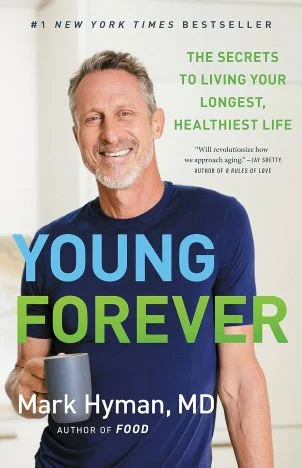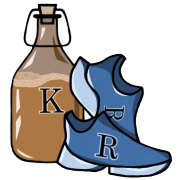
In his book Young Forever, Dr. Mark Hyman—head of functional medicine at the Cleveland Clinic—lays out a powerful argument for rethinking how we approach aging and chronic disease. Rather than patching up symptoms with medication or surgery, Dr. Hyman emphasizes addressing root causes through lifestyle, nutrition, and functional testing. The book dives deep into how aging is driven by “hallmarks” such as inflammation, mitochondrial dysfunction, and poor metabolic health—many of which can be dramatically slowed or even reversed through targeted lifestyle changes.
One of the most compelling takeaways from Young Forever is the distinction between lifespan and healthspan. Most people want to live longer—but more importantly, we want to live well for longer. That means staying sharp, strong, mobile, and disease-free well into our later decades. Dr. Hyman’s message is clear: longevity without quality of life isn’t the goal. The path to extending healthspan includes eating a nutrient-dense diet (mostly plants and healthy fats), reducing stress, fostering community, and integrating movement into everyday life.
Healthspan vs. Lifespan: The Core Message
That message really resonated with me. Our current medical system—what I half-jokingly call the “medical industrial complex”—is great at treating emergencies but terrible at preventing disease in the first place. Doctors will fix your valve, give you a bypass, prescribe cholesterol-lowering drugs… and then serve you biscuits and gravy (true story—my dad got that meal in the hospital right after heart surgery). It’s a system designed to treat symptoms, not root causes. And we keep coming back for more.
Lessons from the Blue Zones
Dr. Hyman highlights the concept of Blue Zones—places around the world where people routinely live to 100 and beyond. These include Okinawa in Japan, parts of Italy and France, and a few spots in the U.S. Despite differing diets, people in Blue Zones share common lifestyle traits: mostly plant-based diets with occasional fish, strong social ties, frequent movement, lower stress, and more natural ways of living. When you take someone out of a Blue Zone and put them on a Western diet—loaded with refined carbs, processed foods, and added sugars—they lose that health advantage. It’s not about genetics. It’s about lifestyle.
Taking the Leap: My Functional Health Testing Experience
Inspired by Dr. Hyman’s approach, I decided to invest in functional testing. My annual labs are generally normal—cholesterol under 200, good triglycerides, not diabetic—but I wanted to go deeper. So I paid $500 out-of-pocket (HSA eligible) for a comprehensive workup: over 105 biomarkers across two separate blood draws. I’ll be honest—20 vials of blood over two weeks was no joke. I fasted for 15 hours before the first draw and almost blacked out. Lesson learned: bring a protein smoothie and sip during the draw. That solved it the second week.
The tests from Function Health checked everything from heavy metal exposure (including mercury, which matters if you eat a lot of fish like I do), to hormone health, nutrient levels, biological age (turns our my biological age is 41 while my chronological age is 54) and advanced cholesterol profiling. That’s where things got interesting.
What My Bloodwork Revealed About Cholesterol
While the total weight of my LDL and HDL numbers were “normal” by traditional measures, the advanced panel revealed that I had too many small LDL particles (the dangerous kind that clog arteries) and not enough large HDL particles (which help clean the arteries). This was eye-opening. The size, and not just the total weight, of the particles matters. The Function Health results included feedback that 75% of heart attack patients have “normal” LDL levels by traditional standards. The standard method—based on weight—is outdated. It’s like using an X-ray when we now have access to MRI-level detail.
Diet, Muscle Gain, and an Unexpected Tradeoff
I suspect this shift in my LDL profile is tied to my recent diet. Since February, I’ve been using Project Lean Nation to help build muscle—adding 4–5 pounds of lean mass—but that’s meant eating a lot more chicken, which is higher in saturated fat than my usual pescatarian diet. While Project Lean Nation meals are convenient and great for muscle-building, I now wonder if they tipped the scale on my cholesterol particle makeup.
Course Correction: Back to a Pescatarian Diet
So here’s the plan. I’m hitting pause on Project Lean Nation and going back to my previous diet—heavy on the plants, fish like sardines and salmon, daily or every-other-day shrimp, and no poultry. I’ll stick with that for a few months and then go back for follow-up testing (included in the $500 package). This experiment is classic My Body Experiment stuff: isolate a variable, tweak it, and measure the effect. I’m skipping supplements for now so I can clearly see the dietary impact.
Why It Matters: Running From My Family History
Why all this effort? Because I’m 54, my daughter is getting married next year, and I want to be here—not just alive, but thriving—for future grandkids. My grandfather died at 63 from a heart attack. As I have shared previosuly, I’m running from that shadow. I want to increase not just my lifespan, but my healthspan. I don’t want to be in my 80s not remembering my wife’s name. I want quality of life, mobility, awareness, and joy for as long as I can.
Final Thoughts: Movement Is Medicine
Stay tuned. I’ll report back in a few months after my next round of testing. Until then—remember: eat real food, move often, and prioritize healthspan over just lifespan and remember that movement is medicine.
And if you feel inspired to try out any of the tests through Function Health, please use my referral link.

Leave a Reply
You must be logged in to post a comment.